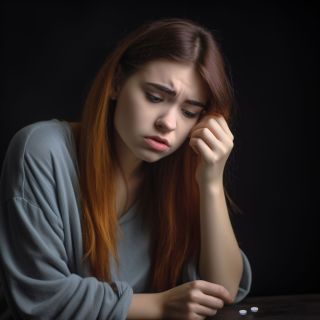Addiction
Is Addiction Driven by the Gut Microbiome?
New research finds a strange connection between gut microbes and addiction.
Posted August 15, 2023 Reviewed by Abigail Fagan
Key points
- Addictive substances can create an unbalanced gut microbiome.
- Poor gut health can exacerbate poor moods via the gut-brain axis.
- Depression and anxiety can increase the urge to use addictive substances.
“Addiction is the only prison where the locks are on the inside.” – Author unknown
Addiction is a mental affliction favoring short-term rewards even in the face of long-term harm. With addiction, we normally think of hard drugs, but people can be addicted to alcohol, cigarettes, and even sugary food. Addictive drugs pump up levels of dopamine and serotonin in the brain, causing a pleasurable "high". The brain sees that as a reward for consuming the drug and connives to get more.

Addiction results in a high rate of preventable deaths. Opioids alone account for some 100,000 victims in the US each year. The social costs run into hundreds of billions of dollars.
People with addiction typically develop tolerance to their drug of choice, leading to snowballing doses and increased odds of bodily harm. Withdrawal is another unsavory characteristic of addiction. Whatever pleasure one derives from the drug, withdrawal subtracts it, leaving the person miserable and prone to relapse.
A new study from Lilach Hadany, Ohad Lewin-Epstein, and colleagues at Tel Aviv University suggests that our microbiome may drive addiction. The existence of the gut-brain axis makes the connection entirely plausible.
How Could the Microbiome Drive Addiction?
The microbes in our gut form an ecosystem. Like any other ecosystem, it requires diversity to stay healthy and resilient. Cocaine, methamphetamines, heroin, alcohol, tobacco, and even sugar, have a significant negative impact on that diversity. Many beneficial microbes are killed outright, while pathogens take advantage of their loss to multiply.
The beneficial bacteria that are suppressed include Lactobacilli and Bifidobacteria. Some of the microbes under attack produce dopamine and serotonin. These are the neurotransmitters involved with feeling good. Unsurprisingly, losing them can ruin one's mood and heighten the desire for more drugs.
The opportunistic pathogens that replace the good bacteria include Flavobacterium, Enterococcus, Fusobacterium, Clostridium, Sutterella, and Ruminococcus. Due to these microbial turnovers, there is a drop in the production of butyrate, a remarkable chemical that both nourishes and heals the gut lining.
This shift away from a healthy microbiome is called dysbiosis. A significant percentage of people with addiction are dysbiotic. Their guts are leaky, allowing toxins and bacteria to enter the bloodstream. From there, the heart obligingly pumps them to every organ in the body, including the brain. Although there is a barrier between the blood and the brain, that can wear down over time. And if toxins and microbes enter the brain, depression and anxiety can result. These gut changes set the stage for self-medication.
Adding insult to injury, once your microbiome switches to this new dysbiotic regime, it can be hard to set it back. Many people suffering from addiction, not comprehending what is causing the mental disturbance, take more drugs in an attempt to improve their mood. That only compounds the problem.
The real solution lies in their gut, but the Israeli study shows that it may be harder to fix than we might hope. They say, “We find that when this ecosystem is exposed to substantial perturbations, the microbiome may shift towards a composition that reinforces the new host state.” In other words, it gets stuck in a rut. They continue, “Such a positive feedback loop augments the imbalances, hindering attempts to return to the initial equilibrium, promoting relapse episodes and prolonging addictions.”
How to Fix the Microbiome
The best way to restore a dysbiotic gut is to provide the good bacteria with proper sustenance. That means plenty of fiber. Sadly, fiber has been successfully removed from most of our processed foods in order to make delicious foods that melt in the mouth. But fresh foods like beans, onions, artichokes, and berries are full of fiber. Prebiotic supplements are another source of fiber. You might also try a probiotic: Bifidobacterium longum and Lactobacillus rhamnosus have been shown to improve the health of the gut lining and prevent the development of drug tolerance.
It can be hard to change a dysbiotic gut while the person is still addicted. But fixing the gut can provide some balm in the form of feel-good neurotransmitters and butyrate — and that can start to weaken the vicious cycle. If you or someone you know is addicted, this is seriously good news. It isn’t magic, but it could kick-start a new life. Pass it on.
References
Lewin-Epstein, Ohad, Yanabah Jaques, Marcus W. Feldman, Daniela Kaufer, and Lilach Hadany. “Evolutionary Modeling Suggests That Addictions May Be Driven by Competition-Induced Microbiome Dysbiosis.” Communications Biology 6, no. 1 (July 26, 2023): 1–11.
Meckel, Katherine R., and Drew D. Kiraly. “A Potential Role for the Gut Microbiome in Substance Use Disorders.” Psychopharmacology 236, no. 5 (May 2019): 1513–30.
Ren, Michelle, and Shahrdad Lotfipour. “The Role of the Gut Microbiome in Opioid Use.” Behavioural Pharmacology 31, no. 2-#x000263 (April 2020): 113–21.
Thomas, Karen R., Jacob Watt, Chuen Mong J. Wu, Adejoke Akinrinoye, Sairah Amjad, Lucy Colvin, Rachel Cowe, Sylvia H. Duncan, Wendy R. Russell, and Patrice Forget. “Pain and Opioid-Induced Gut Microbial Dysbiosis.” Biomedicines 10, no. 8 (July 28, 2022): 1815.


